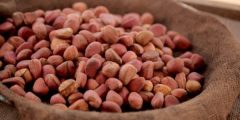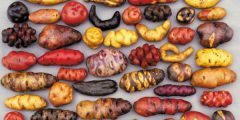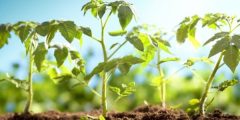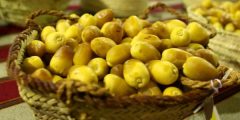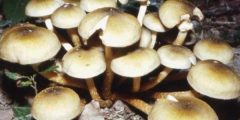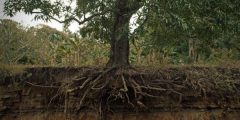Pistachio tree
Pistachios belong to the genus Pistacia (in Latin: Pistacia).[XNUMX] It grows on a small tree belonging to the cashew family, whose scientific name is Anacardiaceae (in Latin: Anacardiaceae). The origin of the tree goes back to Iran, but it is widely cultivated in areas extending from Afghanistan to the Mediterranean region and California. Its seeds are edible roasted or fresh, and they are rich in protein. And fats, fiber, and vitamin (B6). It is also used in the manufacture of many different sweets, such as: baklava, ice cream, and halva. It is used as a food coloring in sweets to give them a yellowish-green color. The pistachio tree grows in warm or temperate climates.[XNUMX] In sunny places, in moist or dry clay or sandy soil, preferably with low acidity and closer to basicity,[XNUMX] Iran occupies first place in the top 10 pistachio producing countries for the year 2018, with its production reaching 551.307 tons, followed by the United States of America, then Turkey, then China, then Syria, then Greece, then Spain, then Italy, then Madagascar, and finally Afghanistan.[XNUMX]
Description of the pistachio tree
The pistachio tree is small to medium in size with branching trunks emerging from the main trunk.[XNUMX] It also has dense, drooping branches and may need to be supported on a stake. It grows to a height of approximately 8 to 9 metres, and may live and produce over several centuries if the appropriate conditions are available for that. Its open shape and attractive leaves also contribute to making it suitable for decoration.[XNUMX] It has gray, pinnate leaves that range in length from approximately 5 cm to 10 cm.[XNUMX] It consists of 5 individual oval leaflets, and has small flowers without petals that are greenish-brown in color, and hundreds of them grow in pink clusters (in English: panicles), and the male flowers grow on trees separate from the female flowers, which makes pistachio trees separate in sex (in English: Dioecious),[XNUMX] It is possible to graft (in English: Graft) a branch from a male tree onto a female tree, and the wind also carries pollen from the male flowers to the female ones to complete the pollination process.[XNUMX]
Read also:What are perennial plants?The fruits of the single-core pistachio (in English: Drupe) are carried in clusters like grapes, red in color and wrinkled. The seeds are the edible part of them, and they have a rectangular pulp approximately 2.5 cm long and approximately 1 cm thick. The color of the pulp ranges between yellow and shades of green. The greater the degree of green color, the better the quality of the pistachios. The pulp is surrounded by a thin, ivory-colored shell that splits lengthwise into two halves when it matures. The pistachio tree usually begins to bear fruit after 5 or 8 years, but full fruiting does not occur until the fifteenth or twentieth year. The tree bears fruit once every two years, and its fruit is affected by climatic conditions, such as: drought, rain, heat, and cold and strong winds.[XNUMX]
How to grow a pistachio tree
Pistachio trees are grown by following the following steps:[XNUMX]
- Multiplication by budding: The required shoots are grafted onto the roots (in English: Rootstock) in the fall, and then planted in the same or the following year depending on the size of the seedling.
- Planting small trees: A hole is dug to a suitable depth that matches the size of the roots, preferably approximately 2.5 cm more than the depth of the pot in which they were previously planted.
- Spacing between trees: The distances that must be taken into consideration when spacing trees depend on irrigation, as they are distributed in a grid pattern at intervals of 6 x 6 meters in irrigated fields, or spaced at intervals of 8 x 10 meters in dry, non-irrigated areas.
- Alternation between male and female trees: The rotation is carried out in a ratio of one male tree to 8 female trees (1:8), or one male tree to 11 female trees (1:11), as the alternation between male and female trees is important for seed production.
- Fertilization: Pistachio trees are fertilized after the first year of planting with approximately 453.5 grams of ammonium sulfate, divided twice during the growing season, and in the following years they are fertilized with nitrogen in an amount ranging from 45 kg to 68 kg per acre of land, divided twice during the growing season, with attention paid to To not fertilize trees after June; Because this may delay the tree’s entry into dormancy, which makes it more vulnerable to damage resulting from frost.
Read also:Benefits of green algae
How to harvest a pistachio tree
harvest
Pistachios become ripe when the outer color of the shell changes from green to red, in late August and the beginning of September. They are harvested within one to three weeks after the color of the shell turns red. This shell can be easily removed from the pistachio by pressing on it with the fingers, but Pistachios that have not turned red but remain green will be difficult to remove the shell from, and it is also evidence that the pistachio is empty on the inside. The readiness of the pistachio trees for harvest is confirmed by shaking one of the branches and counting the amount of kernels that fall from it. It is preferable to harvest the pistachio crop all at once when it is ripe. All the love.[XNUMX]
Peeling and drying
The skin is removed from the pistachios immediately after harvesting. Because their presence leads to stains appearing on the peel and pulp and their rotting. To remove the peels, the fruits are spread on a table topped with a sieve, then the pistachios are rubbed with a cloth. The sieve can be replaced with a rough cloth, and many empty pistachios may be found, as the amount of empty pistachios depends on Its type, the climate in which it grows, the thickness of the root, and the agricultural practices followed. After the peeling process, the pistachio kernels must be immersed in water to separate the shells that float to the surface from the full kernels that do not float.[XNUMX]
Read also:Where is saffron extracted from?Pistachios are dried by spreading them out on a well-ventilated surface with a thickness not exceeding two pistachios. Drying under natural conditions takes 3 to 4 days, or they can be dried using an oven by placing them at a temperature ranging from 60 to 71 degrees Celsius for a period ranging from 10 to 14 days. An hour, by spreading the pistachios on a tray with a relatively small thickness, and turning them from time to time to ensure uniform drying of all the kernels. The pistachios are properly dried when the kernels become brittle and not hard. The pistachios are then stored in tightly closed containers to prevent insects from entering them, as they can be stored with Its peel can last up to a full year at a temperature ranging from 7.2 to 3 degrees Celsius, and for 3 years when the temperature is 17.8. It can also be stored peeled for up to a full year at a temperature of XNUMX degrees Celsius, and for XNUMX years when the temperature is XNUMX. - Celsius.[XNUMX]
The most famous varieties of the pistachio tree
Specific varieties of pistachios are famous in each country, and the following table shows the name of the country and the most famous variety in it:[XNUMX]
| name of the country | The most famous pistachio variety |
|---|---|
| Iran | Akbari, Ahmed Aghaei, and Kalhaghoushi. |
| Syria | Aleppo is red. |
| Turkiye | Ozone and Karmezi. |
| Sicily | Napoletana. |
| أستراليا | Sirora. |
| Mediterranean countries and East and Central Asian countries | Aegina, Al-Ajami, Al-Alami, Ashouri, Avedon, Ayemi, Piazzi, Batory,Bianca, Bianca Regina, Bondoki, Cappuccia, and other types. |

